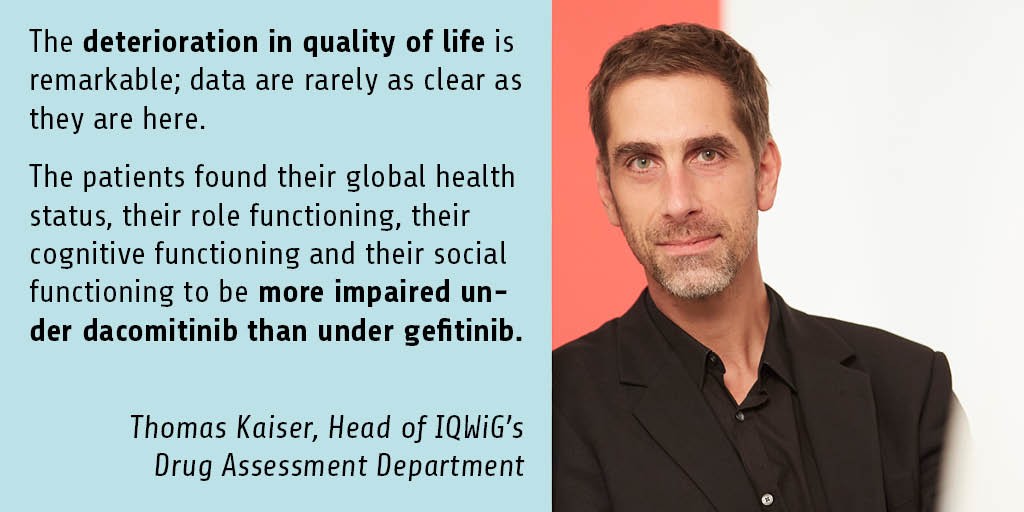Aug 1, 2019
Dacomitinib in advanced lung cancer: large number of disadvantages outweighs survival advantage
Longer survival is offset by partly severe side effects and deterioration in symptoms and quality of life
Since its approval in April 2019, dacomitinib has been available for the first-line treatment of adult patients with locally advanced or metastatic non-small cell lung cancer (NSCLC) with epidermal growth factor receptor (EGFR)-activating mutations. The German Institute for Quality and Efficiency in Health Care (IQWiG) now examined in an early benefit assessment whether this drug offers an added benefit for patients in comparison with the appropriate comparator therapy. The result: While overall survival is longer under dacomitinib treatment, side effects, including severe events, are more frequent. Also, the patients’ symptoms worsen earlier and more often than under the comparator treatment, and their health-related quality of life is worse. Overall, an added benefit in comparison with the appropriate comparator therapy is therefore not proven.
Only data on one of two research questions
The Federal Joint Committee (G-BA) distinguished between two research questions based on the mutation status in the EGFR gene of the tumour cells, since the effectiveness of the treatment options depends on the exact structure of this receptor. For the EGFR mutations “L858R” or “Del19”, the appropriate comparator therapy was another drug of the same substance class, i.e. afatinib, gefitinib or erlotinib. Patients with other activating mutations were to be treated individually depending on the type of mutation in the comparator arm.
The drug manufacturer did not present study data on this second research question in its dossier, so that an added benefit of dacomitinib is not proven for this reason alone. For the first research question, there are data from the unblinded randomized controlled trial ARCHER 1050, in which patients – predominantly Asians – were treated with either dacomitinib or gefitinib.
Patients reported numerous disadvantages
With about 34 months, the median survival time in the dacomitinib arm of the study was just over seven months longer than in the gefitinib arm (just under 27 months). In addition, there were isolated advantages regarding certain side effects. However, this was offset by a large number of disadvantages: Numerous side effects, particularly including severe side effects, were more common under dacomitinib. Patient-reported symptoms worsened more frequently and also earlier. Deterioration of health-related quality of life was also more pronounced than under gefitinib.
“Particularly the deterioration in quality of life is remarkable; data are rarely as clear as they are here," says Thomas Kaiser, Head of IQWiG’s Drug Assessment Department. “The patients found their global health status, their role functioning, their cognitive functioning and their social functioning to be more impaired than under gefitinib.” Overall, the negative effects outweigh the positive effect on overall survival. An added benefit of dacomitinib in comparison with the appropriate comparator therapy is therefore not proven.
G-BA decides on the extent of added benefit
The dossier assessment is part of the early benefit assessment according to the Act on the Reform of the Market for Medicinal Products (AMNOG) supervised by the G-BA. After publication of the dossier assessment, the G-BA conducts a commenting procedure and makes a final decision on the extent of the added benefit.
More English-language information will be available soon (Sections 2.1 to 2.5 of the dossier assessment as well as easily understandable information on informedhealth.org). If you would like to be informed when these documents are available, please send an e-mail to info@iqwig.de.



